OSR Grab Bag by potatocubed
The Black Hack & The Indie Hack
Original SA postRight now I should be writing a couple of XML translations, two backer playbooks for Pigsmoke, and my entry for the Spring Thing.
But fuck that! I'm going to get my OSR on.
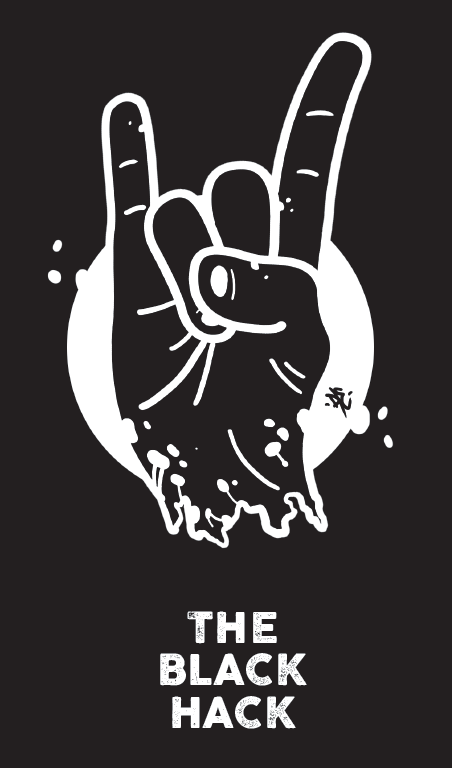
The Black Hack (TBH) is an OSR game released in early 2016 which takes the D&D tropes we're all familiar with here, strips out almost everything not core to the dungeon-crawling experience, and adds some innovations from more modern games. The whole thing is 20 pages long and incredibly popular, spawning about a million billion hacks of itself several of which, ironically, hugely outrank it in a search for 'The Black Hack' on DrivethruRPG.
TBH as it stands is a solid rules-light dungeon crawl engine. Every roll in the game is either an ability test -- the usual six abilities, obviously -- or a damage roll, and the game's almost entirely player-facing: the player tests INT to overcome enemies with magic, for example, the enemy doesn't roll a save; or the player tests STR to block a melee attack instead of the monster rolling to hit. The only times the GM rolls are for monster hit points and monster damage.
The game borrows heavily from all kinds of D&D and D&D-like games: it's got advantage and disadvantage from D&D 5e, 'heal up from zero' from D&D 4e, and uses the Dungeon World convention of damage dice by class rather than by weapon, and unlike certain other games I've seen which steal from all over the place all the parts combine into a very neat whole.
About the only criticism I can level at TBH is one that afflicts a lot of indie RPGs, and that's introducing terms before they're defined. The paragraph on advantage and disadvantage, for example, should sit immediately after the paragraph on testing attributes -- not four pages later. Likewise 'OofA' is used as a term well before it's confirmed to mean 'Out of Action' and what being out of action entails. (Which is: Roll 1d6 on a table of bad things that can happen to you, up to and including death. I like it.)
I'm also only 90% sure how armour points work. I'm pretty certain they're just like hit points that regenerate between encounters, but it's not totally clear.
But those are minor things. The Black Hack is cheap, solid, and I recommend it for your super-light dungeon crawling needs.
"But potato!" I hear you cry. "That was a very short review of a very short game!"
Yes. I reviewed that game, so I could review this one:
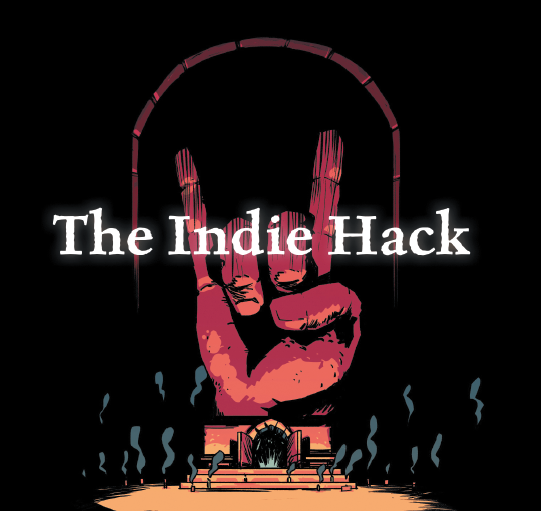
The Indie Hack (TIH) is one of the many, many spinoffs of The Black Hack. It's only fractionally longer -- 28 A5 pages instead of 20 -- and substantially more expensive, likely because it has a bunch of art in it which TBH is entirely missing. TIH purports to be
quote:
a minimalist fantasy roleplaying game, build up from the ideas in The Black Hack
and spoilers: it's not great.
For starters, TBH has lovely clear font choices in a large point size, and is laid out with plenty of white space and a reasonable amount of attention to typesetting. TIH has smaller print, less font variation, is super-cramped, and there's a widow line at the top of the second column of the very first page. Compare:
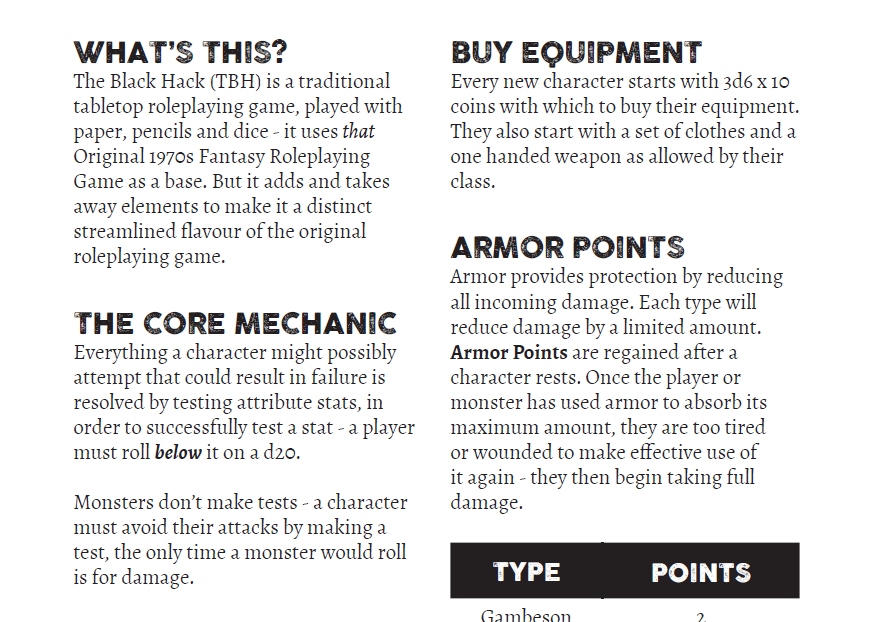
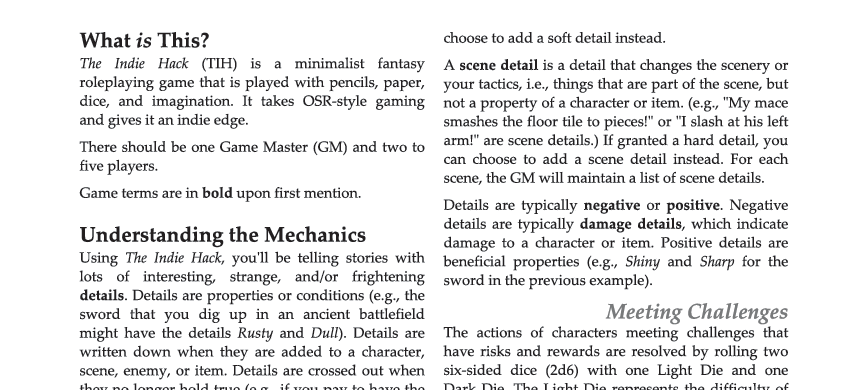
Like I said. Not great. Moving on.
Like TBH, TIH is entirely player-facing. On every roll the player rolls 2d6 -- a 'light die' and a 'dark die'. Confusingly (for me at least), the dark die is the player's die and the light die represents the world set against them. Anyway. Whoever rolls highest gets to add details to the scene and/or characters in it.
Details function like a combination of Dungeon World tags (in that they describe 'statements about things' which are true) and Fate aspects (in that they can be used to adjust 'light die' rolls). Details sometimes have something called capacity which is the number of other (negative) details that have to be applied before the item or character is taken out.
If this sounds like a completely separate mechanic shoehorned in under the heading of 'details' in an attempt to make a system look more unified than it is, you're spot on. Like, I don't have a problem with the concept of capacity -- it's a perfectly fine rules mechanic, similar to Fate's consequences -- or its presence alongside details. I have a problem with stuffing it into a category it has no business being in.
You are allowed to have more than one mechanic in a game!
Anyway.
A brief paragraph on checking the environment which should make perfect sense to PbtA veterans and is probably incomprehensible to anyone else, and then we're onto character generation. You have three attributes -- Tough, Clever, Precise -- which all start at 0. You pick one to add +1 to, get another +1 assigned at random, then get further modifications from your class.
What do these attributes do? Who knows!
No, really. We find out in the section on combat that Tough and/or Precise add to the dark die when you're fighting, so I assume stats are added to the dark die in non-combat situations as well (or Clever would be 100% useless). But it's never explicitly stated..
Sigh.
Now we move on to relationships, which are like Dungeon World bonds. You start with one per other PC, and you can get more by helping them. Helping is pretty simple: the helper rolls an extra 'dark die' and the acting player chooses whether to use theirs or the helper's. If they accept the help then the helper gets a new positive relationship with the helped, and if they reject the help then the helper gets a new negative relationship. Which I think is pretty neat. Relationship explosion is prevented by only allowing helping once per scene.
What mechanical effects do positive or negative relationships have?
None.
Nothing.
It's a neat idea, with absolutely no mechanical backup or support. A blindingly missed opportunity.
Sigh.
Next, every character has a Master (or Masters, or presumably Mistress/es since we're down with that sort of thing round here). This is the person or god or council or whatever you work for -- shades of 13th Age's icons here -- and you start with two details about them. Also:
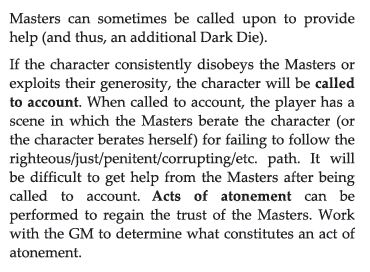
They sometimes provide help. When? How? Who knows!
It can be difficult to get their help when they're angry with you. How difficult? What makes them angry? Who knows!
You can atone to regain their favour. How? WHO FUCKING KNOWS.
Now, there's an argument you can make that at least TIH attempts to provide a structure for this sort of thing whereas e.g. TBH doesn't. Except TBH does because TBH has a robust enough core mechanic to cover almost everything.
Your TBH thief has a master, a thieves' guild, right? They make demands of you as narrated by the GM. You ask them for help? Test Charisma, maybe with advantage if you've got some leverage, see how you do.
Your TIH scoundrel might also have a thieves' guild as a Master. They make demands of you as narrated by the GM. You ask them for help? You... uh... roll for it? I don't know.
Oh, also? If your stats add to your dark die, then your Masters need some sort of numerical rating to add to their helping die. Or they just use your stat. Or it's entirely possible that your stats don't add to non-combat dice at all.
Moving on.
Characters can have natural aptitudes which also offer help dice. This section doesn't mention where these aptitudes come from; later we'll discover that they come from your class.
And again, if stats add to your dark die roll: Do aptitudes use your stat? Some other bonus? The book is silent on this matter.
This section also mentions that characters can have skills and/or spells, which... do... something? Like pretty much everything else here, it's not clear. (Skills and spells make more sense when they appear in the various class descriptions, a few pages later.)
Then we move on to equipment.
The Black Hack tracks money in a very traditional way (count your gold pieces, spend your gold pieces). TIH, on the other hand, abstracts it into something called 'Jingle'. On the one hand, I'm broadly in favour of abstracting money (see also Cred in The Sprawl). On the other hand, Jingle is the most stupid term for it I've ever heard and it annoys me every time I see it.
We take a sharp left into a brief digression about healing -- you turn damage details, which haven't been described yet, into scars when you rest. Is there a limit to your scars? Do they do anything special? Are they purely descriptive? Who knows!
Then we're back to the main equipment list and some words on encumbrance which manage to take a very simple system and make it sound extremely complex. Then armour, which functions as it does in TBH: to absorb damage details which would otherwise be applied to the character. The main difference is that in TBH your armour 'regenerates' between encounters; in TIH once it's reached capacity it has to be repaired in town, at significant cost.
And now... fighting!
In The Black Hack, you check for wandering monsters every fifteen minutes of real time. In The Indie Hack, you check for wandering monsters
quote:
every so often
Sigh.
A wandering monster check is a standard light die vs dark die roll off -- except you add the monster's challenge
More aggravatingly (my emphasis):
quote:
Typical GM details are soft details describing the monster getting closer (after several such details, the monster arrives).
How many is "several"? Who knows!
Although if the GM wins the roll handily enough the monster ambushes the party there and then.
There's some stuff about fighting, which actually fits very neatly into the established system: roll off vs the GM, winner gets to apply details to the loser. Simples. If you get your shit kicked in you're out of action; assuming the party wins the encounter or at least grabs your body on the way out
quote:
the player must test Clever and meet The Three Judges.
What does the Clever test do? Who knows!
I mean sure, it lets you add details to your meeting with the Judges, but since that's a flat d6 roll your details are meaningless. It's completely irrelevant.
The Judges are the Child, the Mother, and the Crone -- props for avoiding the Maiden concept -- and a randomly chosen one is angry with you. Promise to do something for them and they'll bring you back to life with a new hard detail to show they're not happy with you. Try to skip out on the promise and they haunt you, which permanently fills in one of your capacity slots.
And now...
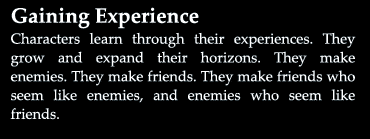
And that's that! On to the character classes!
You'll be pleased to know the character advancement rules continue after the classes section. It's just a really weird place to put the classes.
The classes are the veteran (fighter), exorcist (cleric), hunter (ranger), scoundrel (thief/rogue), elementalist (sort of wizard), occultist (evil wizard), and outlander. Each has a selection of questions as character prompts, a la any number of PbtA games.
Of the seven the outlander is far and away the most interesting. They're a sort of wandering adventurer with limited ESP tormented by the visions of something or someone.
Oh, and every class's weapon proficiencies, skills, and spells are framed as 'positive details'. Remember how I complained at the start of this review about mechanics being shoved into the 'details' suitcase even though they blatantly aren't and don't function in any way like details? Same thing here.
Anyway, back to character advancement!
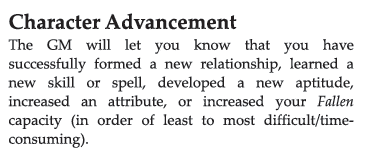
And that's it.
I mean, there are sections which expand what each of those options mean -- what it is to gain a new aptitude, or increase your Fallen capacity, or whatever, but exactly nothing on how you're supposed to adjudicate advancement.
The Black Hack, by the way, assigns player characters a level and says that the GM should pick a 'trigger' for level advancement and stick to it: surviving a dungeon level, surviving a major event, etc. etc. Simple and effective.
Oh wait, wait, I'm wrong. There's a system in the Advanced Rules bit which lets you accumulate 'milestones', which you can then trade in for advances just like they were traditional experience points. This is much better -- in that it's functional -- and should be the base system.
And then...
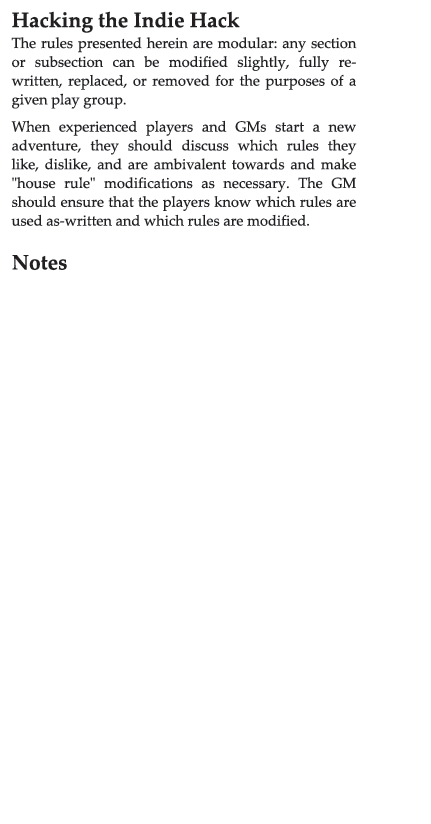
Am I supposed to fill in that space? Maybe?
Then there's a section of monsters and traps and other things that might foul up the PCs, and then...
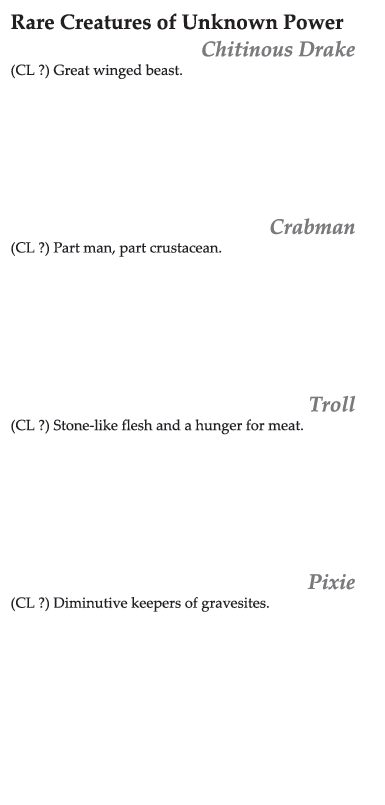
It's probably a joke -- 'unknown power' and all that -- but given the generally unfinished nature of the rest of the book I can't tell. 'Who knows?' to coin a phrase.
And that's my beef with The Indie Hack in general. It's not fucking finished. The Black Hack draws a tight circle around what it's interested in -- old-school dungeon-crawling -- and defines a ruleset to handle that. Like any game there are imprecisions and corner cases and wotnot, but in the end it all resolves down to 'advantage or disadvantage, test a stat'. The Indie Hack is a sort of vague cloud of 'game-ness' which blurs into handwaving at the edges. There is a single resolution mechanic, but since it revolves around adding details it doesn't interact with all the non-detail elements of the system (such as when rolling to gather information about objects, people, or the environment) -- and it interacts really weirdly with the stuff which shouldn't be detail elements but have been crammed in there anyway. Can I use a good roll to grant myself the occultist's ability to raise the dead? A veteran's weapon and armour proficiencies?
Somewhere at the core of The Indie Hack is a good idea, but it needs a massive reworking and a good editor. Also, right now it sits kind of awkwardly between Dungeon World and The Black Hack without being as good as either. I think if you played up the narrative elements of it you could maybe reposition it into a rules-light 13th Age-Black Hack hybrid, where it would have less competition for that niche. But that's just me.
Next time, I'll get onto another OSR game I like: Spaces of the Unknown
Spaces of the Unknown
Original SA post
Spaces of the Unknown (SOTU) is an old-school dungeon-crawler designed by Brent Newhall specifically for online play. To let the game speak for itself:
quote:
This is a dead simple, light, fantasy role-playing game designed to be played on the internet using the most awesome human invention: the written word.
Although definitely light, this one is pretty hefty compared to the two hacks I wrote about yesterday: a whole 34 pages of A4 (although the entirety of the player rules fits on two), small print, not as good-looking as The Black Hack but way nicer than The Indie Hack. From a technical writing point of view it knocks them both into a cocked hat (although it's still not perfect).
We open with an introduction for people new to roleplaying, and an introduction for people who are familiar with D&D. There's nothing for people who are coming to this from non-D&D roleplaying games, but I suspect that demographic is a) unfortunately small and b) not really the target market for this game.
Anyway, I'm going to summarise that summary because it's a pretty good overview. Thus:
- The GM rolls all the dice.
- All PCs are fighters, more or less.
- There are no turns in combat; everyone moves, then everyone attacks.
- You can cast spells from scrolls, or learn them from a mentor.
- No gold. Just equipment (for adventuring) and monster body parts (for use as spell components).
- PCs don't get killed, they get sidelined. While sidelined they can still help out the other PCs.
- The group has a level, not individual PCs. Killing monsters boosts your level.
It's an interesting mix of changes: some to reinforce tone, some to streamline for online play, and some which are just 'quality of life' improvements. It's also the first explicitly GM-facing game I've seen, although I'm sure there must have been others. I know in this case it's because letting the GM roll everything speeds up online play, but still. It's noted.
From there we jump straight into the player rules. The first thing to do is to roll your pre-adventurer background on the handy d20 table, or you can choose one. We'll learn on the next page that 50% of the backgrounds get the ability to identify spell scrolls on sight -- including lords, nuns, doctors, bandits (?) and beggars (???) -- and the other 50% get nothing special, so straight away we've got a mechanical hiccup. It bugs me because there are at least four simple ways to fix it.
Moving on, you choose your armour. A higher AC means a lower movement. Also, although we don't learn this until much later, when you perform fancy actions like jumping, climbing, etc. you roll against your own AC, so lighter armour makes you more able to so stuff like that. That feels quite elegant to me -- no need to track armour check penalties and suchlike -- but I do wish it was mentioned here so players could make an informed choice.
You get 1d8 hit points. It's not mentioned here but when you level up you roll Xd8 where X is your new level, and if the total is higher than your current max hp you get the new total. I like this system. It allows for steady hit point growth but also mitigates the extremes.
You get three choices from the list of weapons, one of which you can trade in for a shield. Weapons come in five categories: small (concealable), improvised (plain bad), melee (standard), ranged (ranged), and two-handed (big damage).
You also get a special item based on your background, which can be anything you like. Some sort of distinctive piece of equipment like Donnel's pot helmet or something. This is a purely roleplaying decision -- I would like to see it get some sort of mechanical support but I'm not sure what that would be off the top of my head.
You also get a 'wilderness pack' which is just a standard collection of adventuring gear. Rations, rope, a fishing rod, usw.
Choose a race (again, no mechanical effect) and a name. And you're done!
There's a brief section on how to play the game
quote:
Hint: Your actions should always push the story forward. When in doubt, act.
a brief section on actions (you get one per round), and an explanation of what it means to be sidelined. Basically, when your hp hit 0 you can't effectively fight any more -- but you can still encourage another PC (granting them +1 on their rolls until you stop or change encouragement) or assist another PC, which involves a risk of failure but offers a +2 bonus to their action if you succeed. Naturally, you have to describe what you're doing to encourage or assist.
You can also still move when you're sidelined. Just not attack or take actions.
A brief section on spells: basically if you have a scroll you can read the scroll, it crumbles to dust and the spell fires. Or you can learn magic from a patron, although what they teach you is up to them.
And some stuff on levelling up (when the GM says, you get extra hp) and extra attacks (which you get sometimes when you level up). Extra attacks are attacks and can't be 'converted' into other actions; they just let you fight while you're doing other stuff.
That's it for the player-facing rules.
The GM rules start on the next page and dive right in with 'this is what you'll need to get started, this is how you do it'. Set up your forum post or G+ collection or whatever, then there's a five-step method to getting started which goes:
- Define a city using the handy random table on the next page.
- Define another city.
- Stick three waypoints on the major trade route between the cities.
- Invent a benefactor who will send the PCs on their mission. (Prompts provided.)
- Choose a lair from the ones in the book as the first adventure.
More 'getting started' advice is in the next section, but we digress for a moment to talk about tone. I'm just going to reproduce this section here because I want to talk about it a bit:
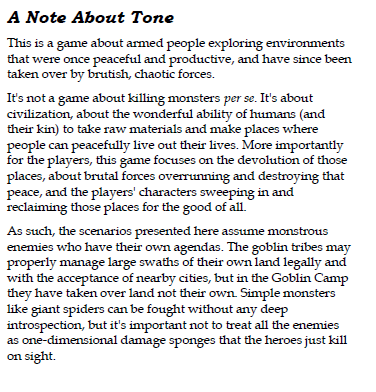
Of the three old-school games I've looked at, this is the first to explicitly set a tone. All of them have a tone, obviously -- The Black Hack is 'general OSR' and The Indie Hack is angling for 'Darkest Dungeon World' -- but only SOTU sits down and lays it out.
But.
Let's take a look at "It's not a game about killing monsters per se." Because the way you level up in this game? Is by killing monsters. In quantity. The tonal description here isn't supported by the mechanics of the game at all. You could fix that -- you could give every lair a condition by which it can be 'restored' or some benefit that defeating it gives to an existing bastion of civilisation, and track 'locations restored' as your XP-surrogate -- but as written the game supports the stabbing of monsters and little else.
The last paragraph raises some interesting questions that go unanswered as well: if the goblin tribes are capable of legally managing their own lands, what is it about the goblin camp that makes it "brutal forces overrunning and destroying ... peace"? Is this an act of war? Wouldn't the correct response be diplomacy, not elite murder teams? It's all very well asking me not to treat the enemies as disposable damage sponges, but the game doesn't support any other approach.
I think if you're going to make a dungeon-crawler you should probably just own the murderhoboing. The PCs are violent people taking back fallen pieces of civilisation from other violent people. If that's the game then that's the game, and pretending it isn't doesn't really help anyone.
But that's a rabbit hole I don't particularly want to go down right now. Moving on.
There's a section on scenes, including some advice for the first three scenes of the game:
- Meet the patron, learn the mission.
- Stop off at a waypoint for some RP.
- Get in the dungeon.
Which is a pretty good start if you ask me. It's also useful for online games because it gives the GM clear steps to follow to keep things moving. Things flagging at the meet and greet? Boom, you're at the shrine/farm/point of local interest saying hi to the people there.
Then we get into the meat of the mechanics. Rules for morale for monsters (when half of them are dead, test once), rules for rest and healing (heal up to full between each encounter), and then the basic structure of the game. All die rolls are either attacks (1d20 + level vs defender's AC), stunts (1d20 + level vs your own AC), or saving throws (1d20 + level vs 15). That's pretty much it.
Monsters don't have a level to add to their rolls, so they tend to get bonuses in their stat blocks. Players can critically hit on attacks (max damage) and crit fail (weapon breaks). Monsters do neither.
Advantage and disadvantage appear here again as well. Because the GM does all the dice rolling it's very much up to them whether or not advantage or disadvantage applies, but a) that's true of every other d20 game that uses it as well and b) this will involve less begging from the players.
There's a section on advancement, which is based on the number of monsters the PCs have defeated -- which includes killing, driving off, negotiating peace with, etc. And a neat bit on further adventures which lays out a solid pattern to follow for the first three adventures and then a handful of suggestions for the next ones.
Next we move on to equipment, which works on a slot basis. You have twelve slots and each slot can hold e.g. 5 torches, 50 feet of rope, 2 flasks of oil, etc. There are also three pre-generated 'packs' provided for dungeoneering, wilderness exploration, and general thieving. Nice and simple.
There's also a random generation table for artefacts -- objects being held or guarded by a monster, for which you want an interesting history. The table runs in five columns from 1-35, 1-22, 1-20, 1-22, and 1-20, so I don't know what sort of dice you're supposed to use it with. Some sort of online random integer generator, I suppose.
By way of an example I rolled 5d20 a couple of times and got:
- a book of lore purchased from a mad king from another dimension
- a decorated shield destined for a scheming merchant in a nearby city
Not bad!
We close out this part of the rules with a page on magic which reiterates what we already know: you either cast it from a one-use scroll, or you persuade someone to teach you an actual spell which you then need to harvest monster bits to cast. You can memorise up to two spells per level, but then you can cast them as often as you like provided you have enough eye of firenewt.
There are also about a dozen sample spells. Spells don't have levels, it's just that people don't teach power word, kill to novices.
There's a page about monsters, which are very simply put together and -- as usual -- compatible with every other OSR game in existence. There's also an explanation here that there's no gold economy in SOTU; unintelligent monsters are harvested for parts, and sapient monsters tend to be guarding unique artefacts like :xx-roll: a cryptic map intended for a treacherous elf prince in a luxurious palace, which tie into or kick off their own storylines.
This is followed by six small lairs (3-4 encoded encounter areas) suitable for kicking off your game, each themed around a separate monster: undead, goblins, insects, lizardfolk, fishfolk, and orcs. Then an edited replay of a game the author played on G+ and a rules cheat sheet.
And that's it!
So. I like SOTU. It's less comprehensive than The Black Hack -- there's nothing in SOTU to help you with non-combat interaction, for example -- despite being more detailed, but it claims a particular area of enterprise and adequately covers everything within that area. I'm particularly fond of the very clear instructions on how to set things up and get started, both for the players and the GM. 'Do this, do this, here are some sample dungeons to get you started, go.' I think more RPGs should do that.
I also like that this game has been designed for play in an asynchronous online environment. You could probably harvest the main innovations here -- GM rolls everything, no turn order -- for use in other online games, but it's nice to see them presented front and centre.
I'm a bit eh about the tone sections, because I prefer my game tone to be mechanically supported, but overall I can live with that. It feels like less of a problem for the GM to manufacture tone at the table -- especially with such a minimal rules engine -- than it does for them to paper over missing rules and weird interactions like they'd have to for The Indie Hack, which actually has a pretty consistent tone thanks to the art. But that might just be me?
Overall, a perfectly respectable addition to the pile of rules-light dungeon crawlers. If I wasn't a PbP disaster I'd run it.